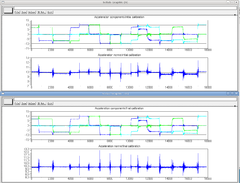ImuCalibration
Accelerometers and Magnetometers calibration is critical for AHRS performances and can be performed using no special hardware. For the magnetometer, it is even very important that the calibration be performed in the fully assembled vehicle, with all systems powered. This is the so-called hard-iron calibration and will allow us to compensate for any constant parasitic magnetic field generated by the vehicle. The calibration process consist in finding a set of neutrals and scale factors for each sensor, such as
The principle of the calibration is the following : An accelerometer, on a vehicle at rest measures a constant vector ( the opposite of gravity ) in the earth frame, expressed in the vehicle frame.
DCM is a rotation matrix that converts between earth frame and body frame. It will change when we change the orientation of the vehicle. Nevertheless, a rotation conserves the norm of a vector. We can thus obtain the following scalar equation that doesn't depend on the vehicle orientation :
We can then record an important number of measurements in different orientations and find the set of scale factor and neutral giving the norm closest to 9.81
Booz comes with a ( very unfriendly ) scilab script to perform this operation ( sw/tools/calibration/calib_accel_mag.sce ). Here is the way to use it
Switch to the "raw sensors" telemetry mode and launch "server" to record a log.
Move the quad in different orientations ( upright, inverted, on nose, on tail, on right side, on left side ) . You can also take some measurememts banking 45 degres.
Try to get an homogeneous distribution of your measurements. I find it better to let the quad rest while measuring. You can then run the scilab script to get your calibration coefficients. It first makes an initial guess using min and max, ie for each axis
neutral = 0.5 * (max + min)
sensitivity = 0.5*(max-min)
It then uses scilab's "datafit" algorithm to optimise the initial guess
Note for magnetometer:



